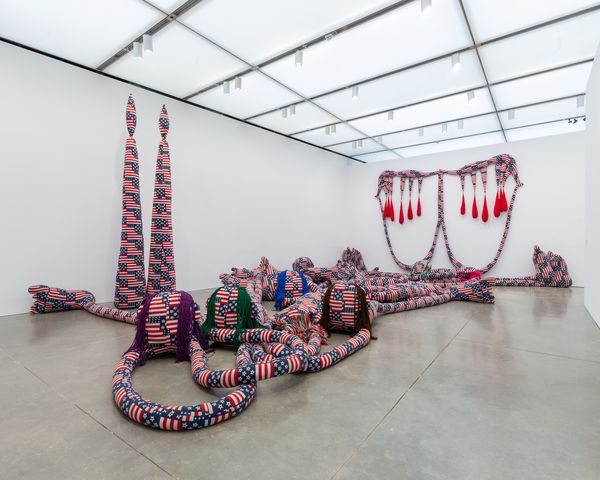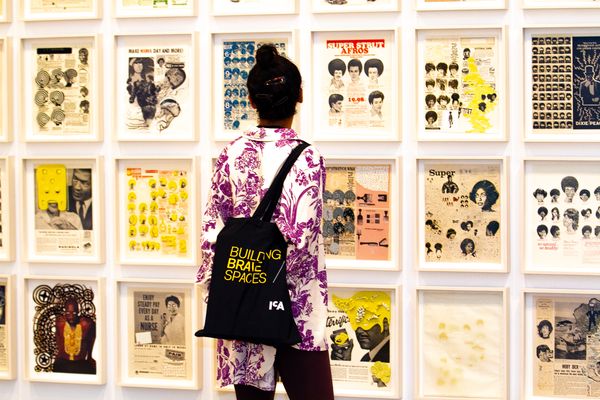PHILLIPS: When life gives you lemons, make lemonade. What has been the upside for you as Director of the ICA Boston, of this challenging period?
JILL MEDVEDOW: The crisis of COVID-19 and the necessary social upheaval and reckoning with structural racism as a museum and a country have had both negative impacts and positive changes. Focusing on the positive, I am energized by the vision of a more just future where art museums are central to a more honest and fuller understanding of ourselves, our history and our humanity. I have been equally inspired during this period by my colleagues at the museum whose commitment, passion and pivots to virtual experiences and learning have been extraordinary. This is not to downplay the financial impact of closure, the worries about health, the economy and loved ones or the challenges of reopening, so it has been a constant balance of uncertainty, anxiety, hope and opportunity for the future.
Sterling Ruby on view at ICA Boston.
P: The ICA co-presented the Sterling Ruby exhibition with the ICA Miami, which offered two fantastic venues for this first museum show. Do you foresee that this will be a more widely used model by museums as they plan for future exhibitions?
JM: It is always rewarding to have more audiences see the fruits of love and labor that go into any exhibition, and I’m so pleased that Sterling’s work and the career it documents through the exhibition and the publication were seen by people in Boston and Miami and now many more online. We are currently working with MoMA PS1 to co-present a major survey of Deana Lawson's work. Another model I’m interested in is sharing acquisitions of works that make sense for two or more institutions to co-own. For example, we recently acquired Purple by John Akomfrah with the Hirshhorn Museum and Sculpture Garden. These collaborations have long term direct benefit to artists, institutions and audiences.
P: Working with living artists is an incredible opportunity for any curator and Museum Director. Is there a specific artist’s commission / project that you want to share with us?
JM: Yes, I’m particularly excited about an upcoming commission with Firelei Báez for the Watershed, our seasonal site across Boston Harbor in East Boston. Originally scheduled for this summer, we’ll now open Báez’s major sculptural installation in 2021. It reimagines the archeological ruins of the Sans-Souci Palace in Haiti as though they emerged in East Boston after the sea receded from the Watershed floor. The Watershed’s location — in a working shipyard and as a trade site and point of entry and home for immigrants over decades — provides a pivotal point of reference. This site-specific installation will invite visitors to traverse passageways and travel through time, engaging with streams of influence and interconnectedness.
ICA Boston Watershed building. © Anmahian Winton. Photo: F. Holzher.
P: Tell us a bit about ICA Watershed and how the ICA Board and the city of Boston supported such an innovative project.
JM: As I mentioned, The Watershed is a seasonal space located directly across Boston Harbor from the ICA in a working shipyard and marina, a six minute ride by water taxi. With architects Anmahian Winton, we renovated this former copper pipe and sheet metal factory — it was derelict and condemned — and brought it back to life as a new, free venue for major artistic installations, community projects and an amazing set of experiences around water, parks, history and art. This project was enthusiastically embraced by our Board, our members, our new neighbors in East Boston, the City, and the Massachusetts Port Authority, that owns the land.
This year, knowing that East Boston has been particularly hard hit by COVID, we are using the Watershed as a site to distribute healthy food and family art projects, working in collaboration with several community partners in East Boston and our ICA caterer, The Catered Affair. I never thought that this would be a way in which we would demonstrate that the arts and the ICA are a resource in this Boston community, but I feel very lucky to help facilitate this. That's my role.
Gallery view, ICA Boston. Photograph: Lauren Miller.
P: What makes the ICA Boston unique in the arena of contemporary art museums?
JM: I might challenge uniqueness as the highest good! What has defined the ICA for over two decades now is our vision of the art museum as the intersection of contemporary art and civic life in Boston, well before civic life became common parlance in the field. We’ve long invested heavily in teen arts education at the museum with over 6,000 teens participating in programs each year; teens are a core constituency for us and educational equity is central to our vision of justice. We’ve pioneered temporary public art projects around Boston that link contemporary arts, history and landscape to build and engage city residents. In fact, I see the Watershed as one of our most substantial and inventive projects in the public realm. Our exhibitions, performances and programs represent the excellence and diversity of a wide range of artistic voices and like so many of our peers across the country, we are committed to ensuring that the arts are of service to our communities and that museums are places of justice and equity. We have extraordinary talent, commitment and collaboration on our staff and our Boards and each of them exemplifies courage, compassion and creativity and our program of exhibitions, performances, education and collection demonstrate that over and over. I think we are unique but I am seriously biased.
Learn more about The ICA Boston >



